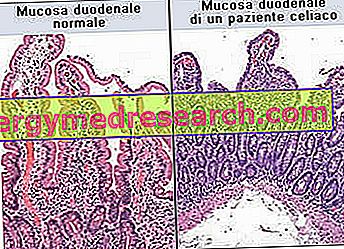Generality
Subcutaneous emphysema is an abnormal presence or collection of air or gas in the tissues located just below the skin (subcutaneous tissues).
As a rule, episodes of subcutaneous emphysema affect the chest, neck or face; however, it should be pointed out that any part of the body can be a victim.

CT scan of a patient with subcutaneous emphysema (indicated by the arrow). Image from wikipedia.org
The most common causes of subcutaneous emphysema are: rib fractures, pneumothorax, pneumomediastinum, perforation of the esophagus, gunshot wounds and stabbing.
The symptoms and signs of a subcutaneous emphysema depend on the anatomical site of the subcutaneous tissues presenting the collection of air or gas.
In general, the diagnosis is based on: physical examination, medical history, radiographic tests and ultrasound tests.
In most circumstances, the treatment of the triggering causes coincides with the spontaneous reabsorption of subcutaneous emphysema.
Possible impediments to spontaneous reabsorption are related to the large size of the air or gas collection; in such circumstances, direct medical intervention is essential.
What is subcutaneous emphysema?
Subcutaneous emphysema is the term that, in the medical field, indicates a condition characterized by the presence, or collected under the skin, in a well-circumscribed anatomical area, of air or more generally of a gaseous substance (gas).
Any part of the human body may be subject to subcutaneous emphysema. However, some anatomical districts are more affected than others, as they were more prone to the development of a subcutaneous emphysema; Among the sites most exposed to the phenomena of subcutaneous emphysema are:
- Chest;
- The neck;
- The face.
MEANING OF "ENFISEMA" AND "SUBCUTANEOUS"
In medicine, it is called "emphysema" any anomalous presence of air or gas in a tissue of the organism, while the term "subcutaneous" describes any condition, event or anomaly, which is located in the tissues located just beyond under the skin.
Causes
The most common causes of subcutaneous emphysema are:
- Rib fractures ( rib fractures ) involving parietal and / or visceral pleura;
- Fractures of facial bones ;
- The episodes of pneumothorax, pneumomediastinum or pneumopericardium ;
- Firearm or knife wounds at chest level ;
- Necrotizing infections resulting from episodes of gas gangrene ;
- Episodes of esophageal perforation . Also known as esophageal rupture, perforation of the esophagus can result from:
- Blunt traumas where the esophagus flows;
- Cocaine inhalation;
- Ingestion of chemicals with corrosive / burning properties;
- Diving injuries (Boerhaave syndrome);
- Pertussis;
- Medical-surgical interventions, which include the insertion of instruments (eg tubes) into the esophagus. Endoscopic procedures, endotracheal intubation, mechanical ventilation or bronchoscopy are possible causes of esophageal perforation;
- Other types of medical-surgical intervention, including oral surgery and cricothyrotomy.
ORIGIN OF AIR PRESENT IN A SUBCUTANEOUS EMPHYSEMA
The air or gas of a subcutaneous emphysema may have at least three different origins or origins:
- It can come from inside the human body . This is the case, for example, of pneumothorax, pneumomediastinum, pneumopericardium, perforations of the esophagus following the ingestion of corrosive substances or oesophageal perforations resulting from certain medical-surgical interventions (eg: bronchoscopy), etc .;
- It can come from the outside . This is the case, for example, of blunt traumas to the chest or face, of rib fractures, of firearm or knife wounds etc .;
- It can be a newly formed substance, which comes neither from within the body nor from outside. This is the case of gas gangrene.
Symptoms, signs and complications
The symptoms and signs of a subcutaneous emphysema vary depending on the anatomical site where the air or gas was collected.
If we analyze the three most common sites of subcutaneous emphysema - namely chest, neck and face - we have that:
- The characteristic symptomatic picture of subcutaneous emphysema in the thoracic area includes chest pain, swelling at the air collection, breathing difficulties, wheezing and crackling during inhalation and exhalation.
- The symptomatic picture characteristic of subcutaneous emphysema at the neck level includes pain in the neck, swelling at the air collection, difficulty in swallowing and changes in the tone of the voice.
- The characteristic symptomatic picture of subcutaneous emphysema at the level of the face includes pain in the face and swelling at the time of air collection.
IS THE AIR COLLECTION FIXED OR MOBILE?
The collection of air or gas from a subcutaneous emphysema can change position and move away from the training site. This event, of course, also involves a variation of the symptomatology: for example, the swelling takes place in the new point where the air collection has moved.
The air or gas of a subcutaneous emphysema can move anywhere, within the human body; however, some anatomical sites, such as limbs and abdomen, are more interested than others.
WHEN TO REFER TO THE DOCTOR?
By itself, subcutaneous emphysema is not a clinically relevant issue; however, its presence generally requires immediate medical intervention, as the triggering conditions are emergencies, which endanger the subject's life.
Diagnosis
In general, the diagnostic procedure for the detection of a subcutaneous emphysema includes:
- The physical examination . The observation of the signs (eg swelling) and the description of symptoms by the patient are two elements that, in many circumstances, are sufficient to draw up a definitive diagnosis of subcutaneous emphysema.
- The anamnesis . Provides information on when and after which event the symptoms appeared. All this can help you trace the causes accurately.
- Radiographic examinations (eg X-rays or CT scans) and ultrasounds . They are confirmatory tests, which doctors use when they have any doubts or doubts about the diagnosis of subcutaneous emphysema.
Their construction provides clear information on the exact location and size of the air collection.
Therapy
In most cases, with the treatment of the underlying causes of subcutaneous emphysema, the latter disappears spontaneously, undergoing a process of resorption .
As stated, the causes of subcutaneous emphysema are conditions of a certain clinical relevance, which normally require immediate and sudden medical intervention (think of the urgency of a gunshot wound).
WHAT CAN PREVENT SPONTANEOUS SAVINGS?
Generally, the marked size of air or gas collection prevents the spontaneous reabsorption of a subcutaneous emphysema. Of norms, the marked dimensions of the air or gas collection represent a typical characteristic of the most severe subcutaneous emphysema.
To cope with a large subcutaneous emphysema that does not spontaneously reabsorb, the solution is to aspirate the air, by means of a catheter or through minor surgery.
WHAT TO DO IN THE PRESENCE OF RESPIRATORY DIFFICULTIES?
The episodes of subcutaneous emphysema, which cause serious respiratory difficulties, could make the use of a support for spontaneous breathing ( mechanical ventilation ) and / or so-called oxygen therapy indispensable.
Prognosis
In general, if the treatment of the triggering causes is appropriate and timely, the episodes of subcutaneous emphysema have a positive prognosis and do not require any particular intervention by the doctor (as far as resorption is concerned).
On a possible negative prognosis of subcutaneous emphysema, the most influential factors are: a very serious triggering condition and failure to treat the latter.
Prevention
By adopting all the precautions necessary to avoid the occurrence of the triggering conditions, an individual can prevent, quite effectively, episodes of subcutaneous emphysema.



